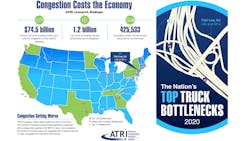ATRI tallies up the worst truck bottlenecks in its annual list
The American Transportation Research Institute (ATRI) recently released its annual list highlighting the most congested bottlenecks for trucks in America.
The worst freight bottleneck once again is in Fort Lee NJ, and Texas had the most bottlenecks in the country with 11.
The 2020 Top Truck Bottleneck List assesses the level of truck-involved congestion at 300 locations on the national highway system. The analysis, based on truck GPS data from more than 1 million heavy-duty trucks uses several customized software applications and analysis methods, along with terabytes of data from trucking operations to produce a congestion impact ranking for each location.
ATRI’s truck GPS data also is used to support the US DOT’s Freight Mobility Initiative. The bottleneck locations detailed in this latest ATRI list represent the top 100 congested locations, although ATRI continuously monitors more than 300 freight-critical locations.
The intersection of I-95 and SR 4 in Fort Lee retained its title as the No 1 freight bottleneck in the country. The rest of the Top 10 includes:
- 2. Atlanta: I-285 at I-85 (North)
- 3. Nashville: I-24/I-40 at I-440 (East)
- 4. Houston: I-45 at I-69/US 59
- 5. Atlanta GA: I-75 at I-285 (North)
- 6. Chicago IL: I-290 at I-90/I-94
- 7. Atlanta GA: I-20 at I-285 (West)
- 8. Cincinnati OH: I-71 at I-75
- 9. Los Angeles CA: SR 60 at SR 57
- 10. Los Angeles CA: I-710 at I-105
“ATRI’s bottleneck analysis is an important tool for TDOT as we work to maximize the safety and efficiency of our transportation system, and ensure we are making the smartest investments possible,” said Dan Pallme, the Tennessee Department of Transportation’s assistant bureau chief for freight and logistics. “The additional capacity we are providing as part of the ongoing I-440 Reconstruction Project should improve the safety and reliability of this important corridor, which we know is critical to freight movement.”
ATRI’s analysis, which utilized data from 2019, found that the number of locations experiencing significant congestion—with average daily speeds of 45 mph or less—increased 92% in only five years, far outpacing the 10% growth in traffic congestion for that same time period.
“ATA has been beating the drum about the continued degradation of our infrastructure, and thanks to ATRI’s research we can see exactly how decades of ignoring the problem are impacting not just our industry but our economy and commuters everywhere,” said Chris Spear, CEO of American Trucking Associations. “This report should sound the alarm for policymakers that the cost of doing nothing is too high, and provide a roadmap of where to target investments to really solve our nation's mounting infrastructure crisis.”
The 11 bottlenecks in Texas are:
- 4. Houston: I-45 at I-69/US 59
- 14. Houston: I-10 at I-45
- 16. Austin: I-35
- 17. Houston: I-45 at I-610 (North)
- 18. Dallas: I-45 at I-30
- 23. Houston: I-10 at I-610 (West)
- 43. Dallas: US 75 at I-635
- 53. Houston: I-610 at US 290
- 55. Houston: I-10 at I-610 (East)
- 73. Houston: I-610 at I-69/US 59 (West)
- 90. Ft Worth: I-35W at I-30
“Everything is bigger in Texas, including our congestion challenges,” said John D Esparza, CEO and president of the Texas Trucking Association. “With a growing population, projected increases in economic activity as a result of the recently ratified USMCA and overall growth, we need to quickly tackle our infrastructure issues. Trucks play a critical role in our economy and if they’re slowed down by congestion and poor roads, it impacts everyone from the shopkeeper to the shopper.”
For access to the full report, including detailed information on each of the 100 top congested locations, visit ATRI at truckingresearch.org.
